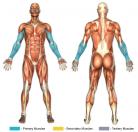Reverse Curls (Barbell)
- Grasp a barbell with an overhand grip (i.e. with your thumbs facing one another), stand with your legs about shoulder-width apart, and rest the barbell against your thighs. Note: You may either grip the bar with your thumbs on top of the bar or under the bar. See "Further Clarification" for elaboration.
- Curl the weight upward, exhaling throughout the movement. Be sure to keep your wrists in a straight, neutral position.
- Lower the weight to your thighs, inhaling throughout the movement.
- Repeat steps 2-3 for as many repetitions as are desired.
Reverse curls are superb for strengthening the wrists, and building the extensors (of the forearms), brachioradialis (of the forearms), and brachialis (of the biceps). The biceps brachii are also worked secondarily.
Many athletes, such as martial artists, boxers, and competition bench pressers, use reverse curls to strengthen and balance their wrist/forearm strength, being as the forearm flexors are often used considerably more than the forearm extensors, and, consequently, are often non-proportially stronger.
This exercise is performed with fully pronated forearms (i.e. the grip is such that the thumbs are pointed toward one another and the palms are facing downward). The bar may be gripped with the thumbs on top (i.e. false grip) or with the thumbs under and fully around the bar (i.e. standard grip). The standard grip may allow for slightly more weight to be lifted, while the false grip may challenge the forearms and wrists slightly more, though at greater risk of dropping the bar.
Forearm exercises, in general, pose a high risk for wrist strains/sprains and other related problems. To help avoid problems of this sort be sure to practice strict form and use lighter weights--at least until a strong comfort level is achieved. Forearms are like calves in that they can perform a rather high amount of repetitions and sometimes even require a high amount of repetitions to achieve the desired result, whether it be overall strength or mass.





